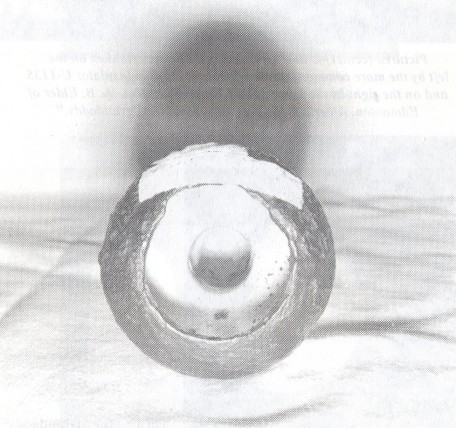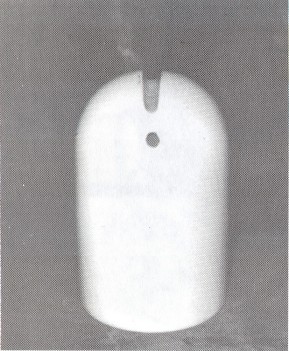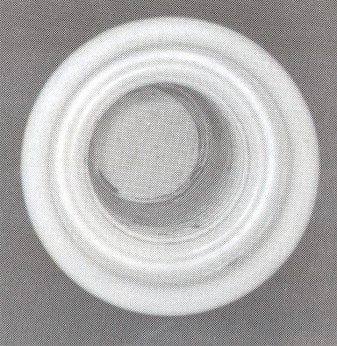Frederick Newton Gisborne, 1824-1892
by Eric Halpin
Reprinted from "Crown Jewels of the Wire", December 1991, page 10
The somewhat plain, white and moderate in size, porcelain insulator U-1135
bears the dome incuse words "Gisborne Pattern." Such a humble insulator
belies the significance of the great man of enterprise and energy who designed
it.
Born into a well to do family in England, Frederick Gisborne was extensively
schooled and excelled in mathematics, botany and civil engineering. His
ancestor, Sir Isaac Newton, would have been proud of the young man's scholastic
achievements, but books and formal studies could not hold Frederick's attention
forever. In 1842, at the age of 18, he undertook a three and one-half year
around the world journey to further advance his understanding of the many areas
of interest that swirled in his mind. But eventually the rugged demands of world
travel took its cost and Frederick settled down, for a period, to farm in the
Province of Quebec.

By 1847 Frederick had graduated with honors from the first
Canadian school for telegraphers and was quickly hired by the recently formed
Montreal Telegraph Company. His knowledge of the workings of the telegraph soon
propelled him to head the main exchange in Quebec. The rapidly expanding
telegraph industry was always on the lookout for new talent and so it was
natural that Gisborne came to people's attention. The "British
North-American Telegraph Association" lured Gisborne away with a position of general manager. His
mandate was to promote the establishment of connecting lines from the Maritime
Provinces with the rest of Canada and the United States. Under his personal
direction, lines were established east from Quebec City towards the Province of
New Brunswick and from Halifax, Nova Scotia west towards New Brunswick.
From
1849-1851 as superintendent and chief operator of all government lines in Nova
Scotia, the serenity of married life and his dormant wanderlust for travel
battled. Taking a leave of absence, he moved to the Island of Newfoundland and
with governmental assistance began to explore the uncharted interior, scouting
for a suitable path for a planned telegraph line to run from St. Johns to Cape
Ray. The topography was brutal, alternating between bogs and marshes to sheer
2,000 foot, heavily fractured tectonic plates forming impenetrable valleys.
Chunks of inner earth littered the wind swept barrens. None of the six man
exploratory work party could complete the initial 400 mile trip except Gisborne
himself and it was three months before he completed the survey at a mere cost of
$2,000.
The task of completing the Newfoundland line was so demanding on his
time that Gisborne resigned from the Nova Scotia telegraph and worked on the
"Newfie" line full time. However, even the optimistic Gisborne was
unprepared for the tribulations to complete this line. Before long this
telegraph project had bankrupted Gisborne and he had to relinquish much of his
control in 1854 to his new-found and moneyed partner, Cyrus Field, of Atlantic
cable fame. This reversal of business fortunes, compounded by the sudden passing
of his wife would have laid most men down for the count. Yet, by the end of
1856, not only had he finished this telegraph line with the aid of his partners
but had laid the first under water line on this side of the Atlantic, between
Prince Edward Island and New Brunswick. He realized his dream of extending the
line all the way to England was out of his reach due to a lack of the massive
financial backing that such a project would require. Now Gisborne sought out new
conquests for his seemingly never dry reserve of energy and ideas.
Always an
inventor at heart, Gisborne developed a system for paying out line during
underwater construction and an insulation that resisted salt water. He also
designed a chisel-scoop post hole digger which was acclaimed throughout North
America. Other inventions included a flag and ball semaphore signal for ships,
an electric recording target, an anti-induction cable and improvements to gas
illumination devices. Numerous international scientific awards were presented to
Gisborne for his achievements and telephony. But books were only books and the
lure of world travel called once again. In 1859 he was off to New Zealand
studying geological and mining opportunities only to return to England by 1862
and represent various mining interests. Unable to settle he returned to
Canada to become chief engineer of a large Nova Scotia coal mine to build two
railway systems in the province. It was during one of his frequent arduous field
explorations that he suffered a near fatal gunshot wound. Maybe now was the time
to slow down a bit!
The magic of telegraphy, however, never left him and in 1879
Gisborne was hired by the Dominion Government Telegraph and Signal Service to serve as
a district superintendent. His adventures in this position, while personally
inspecting the lines across Canada, are another story in themselves. For the
next 13 years, besides fulfilling his normal duties, Gisborne was in demand
lecturing at universities and continuing to patent telegraph, telephone and
electric devices. Of particular interest to insulator collectors is Canadian
patent #22449. In this 1885 patent, Gisborne advanced the idea of using tubular
iron telegraph poles and cross arms. These proved to be most useful in the
treeless prairies due to problems with fires, buffalo rubbing damage and travelers
and teamsters tending to use the wooden poles for fuel. The higher initial cost
of the 16 foot poles was offset by the reduced transportation costs, since
each pole weighed only 42 pounds. By 1888, some 3,500 iron poles had been
erected with further orders placed. Only a limited number of these iron poles
have survived the world war scrap drives.

Gisborne has been involved with several insulator styles. The rare iron
insulator (pictured above and below) is owned by Mike Moon
(Manchester, MI) appears to be a Gisborne insulator based on reference material
from an electrical and Civil engineers review of Gisborne's work dated 1888.
These insulators were used extensively in Prince Edward Island around 1852.
Another rare Gisborne insulator that has not been assigned a U-number , is a
large white porcelain insulator which Jack Tod called the "Gisborne
Granddaddy". It is 4-5/8 " wide and 7-1/4" tall with an inner
petticoat and takes a 2-1/2" pin. This insulator has an incuse marking of
small black letters reading "Gisborne Pattern" along the dome side.
Considering the size of the saddle wire groove, the insulator clearly is
oversized for a mere telegraph wire. However, it has been reported that years
ago, a few surviving Indians recounted that these insulators were used along the
lines where they crossed rivers. Thus, Gisborne may have seen a need for a far
heavier duty insulator for such an application of long spans.

A view of the underside and pinhole of the iron insulator.

Pictured (center) is the "Granddaddy Gisborne" flanked on the
left
by the more common, smaller Gisborne Pattern insulator U-1135
and on the right
by the large U-981 Flint Elliott Hat. L. B. Elder of
Edmonton, Alberta is the
proud owner of the "granddaddy."

Turning the "Granddaddy Gisborne" a few degrees
clearly shows the
"hole-through" in its dome.

A view of the top of the dome shows the
wire groove and the hole-through
design.

Another comparison photo depicts the size
of the pinhole of the
"Granddaddy Gisborne".

A 2-1/2 inch pin could be accommodated by the pinhole.

The incuse embossing on the side of/he insulator reads:
GISBORNE PATTERN
The common U-1135 white porcelain insulator has an incuse marking above the
wire groove in three different styles; one is the same as the
"Granddaddy"
GISBORNE PATTERN
Another is also a one line marking with the
"G" and "P" being twice the size of the previous block
letters:
" GISBORNE
PATTERN".
The third variety has the word "Gisborne" over the word
"Pattern" with the letters being large block letters of about double
the smaller size:
GISBORNE
PATTERN
The "Dwight Story" in the January, 1989 issue of Crown Jewels
connected the similarities of the CD 143, Style 2, "Dwight/Pattern"
insulator and the U-1135. It is my belief that Mr. Dwight liked the basic style
of the Gisborne insulator and copied it for his own applications in the early
1900's. The U-1136 and U-1137 are very similar in overall style to the U-1135
and retain the same characteristics "Gisborne" base indentation. The U-1135's are usually found in either white or off-white underglaze color tones.
Unincised varieties are also found as above plus a scarce chocolate brown
underglaze.
 |
 |
 |
| Permission granted by author for use of drawings to illustrate story. |
Early collectors of these Canadian porcelain insulators had decided that they
were likely made by Bullers in England, based on company catalog information.
While I won't dispute this, I don't understand why it wouldn't have made more
sense to have them manufactured at his choice of any of the several porcelain
plants in North America. Canadian Pacific purchased 250,000 "Gisborne"
insulators by 1888 at a cost of 7 cents each. This compares with a Canadian
Pacific cost of 5 cents each for comparable glass insulators of the period.
Gisborne's insulators can still be seen in use along the C.P. lines, albeit in
fewer quantities, as the lines come down. Their availability in the future is
limited.
Mr. Gisborne belonged to a unique group of men to whom difficulties in
connection with a project added to its fascination and inspires as to its
achievement. In 1892, despite failing health and against doctor's orders, Mr.
Gisborne, feeling duty bound, undertook an inspection of the east coast
telegraph lines. He died shortly thereafter, giving of himself to the telegraph
that he revered.
| 